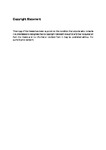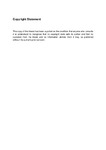Developing an integrated strategy for the assessment of hazardous substances in Kuwait’s marine environment
| dc.contributor.supervisor | Jha, Awadhesh N | |
| dc.contributor.author | Alsarawi, Hanan Ahmad | |
| dc.contributor.other | Faculty of Science and Engineering | en_US |
| dc.date.accessioned | 2018-01-17T15:19:54Z | |
| dc.date.issued | 2017 | |
| dc.date.issued | 2017 | |
| dc.identifier | 10478066 | en_US |
| dc.identifier.uri | http://hdl.handle.net/10026.1/10603 | |
| dc.description | Edited version embargoed until 17.01.2019 Full version: Access restricted permanently due to 3rd party copyright restrictions. Restriction set on 17.01.2018 by SE, Doctoral College | |
| dc.description.abstract |
Kuwait is undergoing rapid economic growth involving substantial developments along its coastal shores and the marine environment. Many of the activities in the region are associated with oil industry, which can pollute the shores leading to contamination from oil residues, tar balls and trace metals. About 2 million barrels of oil are spilled annually from routine discharges into the Gulf, which derives mainly from dirty ballast waters and tank washing. The comprehensive literature review of hazardous substances in Kuwait’s marine environment has concluded that for the majority of these pollutants, contamination is localized around industrialised areas, and elsewhere is generally below the permitted international standards. These finding have been supported by a fieldwork. This has been conducted to assess the use of biomarkers (bile metabolites and EROD activities) for 60 fish consisting of two native species Giant sea catfish (Arius thalassinus) and (Pelates quadrilineatus) to demonstrate the potential for the concentrations of oil based contaminants present to induce detectable levels of biological effects in fish species living in Kuwait’s marine environment. Therefore, the focus of this research has shifted its attention to another anthropogenic source that chronically pollute Kuwait’s marine environment. One of the main sources of contaminants is the continuous discharge of sewage, which impacts many locations around Kuwait. Sewage is known to contain wide array of substances that could pose an ecotoxicological impact at different levels of the ecosystem. One such threat is posed by antimicrobial agents that contribute to the growing global concern surrounding the prevalence of antimicrobial resistant (AMR) bacteria. Therefore, a major theme of this research project was to conduct a novel survey of the prevalence of AMR bacteria isolated from Kuwait’s marine environment. The AMR screening, including 598 E.coli isolated from seawater and bivalves samples during summer and winter seasons against 23 frontline antibiotics, revealed that resistance was observed from a number of locations (particularly associated with sewage outlets) for the majority of antibiotics (seawater: summer 89 - 64%; winter 90 - 57% and bivalves: summer 77%; winter 88%). A baseline screening for the class 1 integron which is known to be implicated in disseminating the antimicrobial resistance among bacteria was conducted for the isolated 598 E.coli. The findings highlighted the prevalence of such molecular genetic elements especially around the sewage outlets (36% of tested E.coli). The whole genome sequencing was conducted for a representative E.coli (26 E.coli) and it showed that E.coli derived from Kuwait’s marine environment possessed a variety of genes implicated in antimicrobial resistance potential against wide spectrum of antibiotics and suggesting that genes are exchanged via the horizontal gene transfer. These observations and recording of antimicrobial resistance phenomenon support the notion that marine environment could act not only as a reservoir for antimicrobial resistance but could also play a significant role in driving it. The AMR bacteria is considered as an effective tool for monitoring the impacts of sewage pollution. Furthermore, it highlights one of the key human health risks sewage pollution poses and its assessments allows a fully integrated health assessment of Kuwait’s marine environment to be undertaken. This will ultimately lead to recommendations outlining the future monitoring and remediation requirements required by Kuwait to tackle this issue including rational antibiotics consumption and stewardship; developing effective wastewater treatment processes to improve removal efficiency of these pollutants in sewage treatment plants; more researches on this area will provide scientific information for responsible authorities to make up regulatory standards and guidelines to control environmental dissemination of these emerging contaminants. | en_US |
| dc.description.sponsorship | Cefas ref:C6061 | en_US |
| dc.language.iso | en | |
| dc.publisher | University of Plymouth | |
| dc.subject | E.coli | |
| dc.subject | AMR, antimicrobial resistant bacteria | |
| dc.subject | Pollution monitoring | |
| dc.subject | Antimicrobial resistant bacteria, AMR | |
| dc.subject | Kuwait marine environment | en_US |
| dc.subject.classification | PhD | en_US |
| dc.title | Developing an integrated strategy for the assessment of hazardous substances in Kuwait’s marine environment | en_US |
| dc.type | Thesis | |
| plymouth.version | non-publishable | en_US |
| dc.identifier.doi | http://dx.doi.org/10.24382/485 | |
| dc.type.qualification | Doctorate | en_US |
| rioxxterms.funder | Kuwait Foundation for the Advancement of Sciences | en_US |
| rioxxterms.identifier.project | P115-64SE-01 | en_US |
| rioxxterms.version | NA |
Files in this item
This item appears in the following Collection(s)
-
01 Research Theses Main Collection
Research Theses Main



